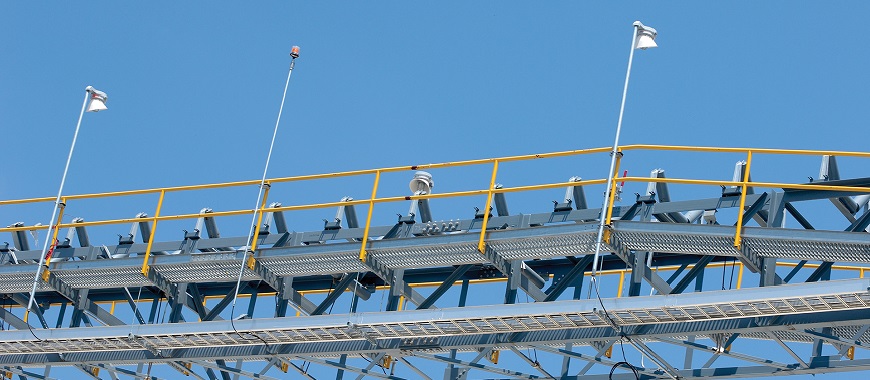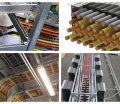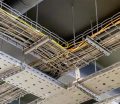
A coaxial cable tray is an essential solution for managing coaxial cables in complex installations. These systems address the challenges of cable organization by providing structured pathways that prevent tangling and physical damage. Proper use of a coaxial cable tray enhances signal quality, reduces maintenance time, and increases cable durability, ensuring optimal system performance. This makes it an indispensable component in applications such as broadcasting, telecommunications, and data centers, where reliability and efficiency are critical. By organizing cables effectively, a coaxial cable tray supports airflow, prevents overheating, and allows easy access for future upgrades or repairs, making it a vital asset for high-demand environments.
What Are The Essential Features of a Coaxial Cable Tray System?
A coaxial cable tray plays a vital role in organizing and protecting coaxial cables in a variety of applications. These trays ensure the cables are properly managed, maintain their performance, and adhere to safety standards. Below, we explore the factors, benefits, and design considerations of a coaxial cable tray system.
Benefits of Using a Coaxial Cable Tray
Implementing a coaxial cable tray offers numerous advantages for managing coaxial cabling in residential, commercial, and industrial environments. Key benefits include:
- Improved Organization:
Coaxial cable trays provide structured pathways, keeping cables orderly and minimizing tangling or damage. - Enhanced Cable Protection:
These trays shield coaxial cables from physical damage, environmental factors, and potential interference. - Safety Compliance:
A well-designed coaxial cable tray ensures installations meet safety regulations, reducing risks of electrical hazards. - Maintenance Efficiency:
Open designs and clear organization allow technicians to locate and service cables more easily, minimizing downtime. - Future Scalability:
Coaxial cable trays can be designed with extra capacity to accommodate future cable expansions, reducing long-term costs.
Factors Influencing Coaxial Cable Tray Selection
Selecting the right coaxial cable tray depends on various factors that align with specific project requirements. Important considerations include:
- Material Selection:
Common materials include fiberglass, aluminum, and steel. At GangLong Fiberglass, we offer FRP trays known for their durability and lightweight properties. - Load Capacity:
The tray must support the weight of the cables without compromising its structural integrity. - Environmental Conditions:
Trays installed in harsh environments should be resistant to corrosion, UV radiation, and extreme temperatures. - Installation Space:
The available space influences tray dimensions, which must accommodate the cables while fitting within the designated area. - Compliance Standards:
Ensuring the tray meets industry safety and performance standards is crucial for regulatory approval and operational reliability.
How to Ensure Proper Installation of a Coaxial Cable Tray
Installing a coaxial cable tray requires careful planning and adherence to best practices to optimize its performance. Recommended practices include:
- Performing Load Calculations:
Calculate the total weight of the cables and ensure the tray’s capacity exceeds this amount, factoring in future expansions. - Maintaining Proper Spacing:
Leave sufficient space between cables to prevent overheating and allow for easy maintenance. - Securing Trays Firmly:
Use appropriate brackets, clamps, and fasteners to ensure the tray remains stable and secure during operation. - Protecting Against Environmental Factors:
In outdoor installations, use covers or sealing techniques to shield the cables and tray from weather-related damage. - Conducting Regular Inspections:
Periodic checks ensure the tray remains in good condition, and any issues can be addressed promptly.
Applications of Coaxial Cable Tray Systems
Coaxial cable tray systems are versatile and widely used across various industries for their reliability and efficiency. Common applications include:
- Telecommunications:
These trays manage coaxial cables for transmitting data and signals in telecom networks. - Broadcasting:
Coaxial cables used in radio, television, and satellite systems are protected and organized using cable trays. - Residential Buildings:
Homes with complex media systems benefit from the structured management of coaxial cables provided by these trays. - Commercial Facilities:
Office buildings and retail spaces use coaxial cable trays to support networking and communication systems. - Industrial Plants:
Coaxial cable trays are essential for managing communication and monitoring systems in manufacturing and processing facilities.
Challenges in Designing Coaxial Cable Tray Systems
Designing an effective coaxial cable tray system involves addressing several challenges to ensure optimal functionality. These challenges include:
- Cable Volume Variability:
Determining the number and size of coaxial cables to be accommodated can complicate capacity planning. - Environmental Constraints:
Trays in extreme conditions require specific materials and protective measures to maintain durability. - Interference Mitigation:
Proper spacing and grounding techniques are necessary to minimize signal interference among cables. - Future-Proofing:
Designing a tray with sufficient capacity for future expansions without overestimating current needs is critical. - Installation Errors:
Poor alignment, insufficient spacing, or inadequate securing of trays can lead to inefficiencies and safety risks.
Innovations in Coaxial Cable Tray Technology
Advancements in materials and design have significantly improved the functionality and usability of coaxial cable trays. Innovations include:
- Modular Designs:
Modular coaxial cable trays allow easy adjustments and expansions, accommodating changing needs. - Smart Monitoring Systems:
Integrated sensors can monitor tray conditions and detect issues such as overheating or overloading. - Lightweight Materials:
Advanced materials, such as those used by GangLong Fiberglass, offer high strength and resistance while reducing weight. - Enhanced Ventilation Features:
Modern tray designs promote better airflow, preventing cable overheating and maintaining performance. - Custom Fabrication Options:
Customizable trays tailored to specific project requirements optimize space utilization and operational efficiency.
How GangLong Fiberglass Supports Coaxial Cable Tray Solutions
GangLong Fiberglass specializes in providing high-quality coaxial cable tray systems designed to meet diverse needs. Our offerings include:
- Durable FRP Materials:
Our trays are made from fiberglass-reinforced plastic, combining strength, corrosion resistance, and lightweight properties. - Custom Designs:
We work closely with clients to deliver tailored solutions that meet their unique project specifications. - Expert Guidance:
Our team provides technical support and installation advice, ensuring optimal performance of coaxial cable tray systems. - Sustainable Practices:
We prioritize eco-friendly manufacturing methods while delivering durable and reliable products. - Comprehensive Product Range:
From ladder trays to solid-bottom designs, we offer a variety of options to suit different applications.
Best Practices for Maintaining Coaxial Cable Tray Systems
Proper maintenance ensures the longevity and efficiency of coaxial cable tray systems. Essential practices include:
- Inspecting for Damage:
Regularly check trays for signs of wear, corrosion, or physical damage and address any issues promptly. - Clearing Debris:
Remove accumulated dirt or debris to prevent interference with cables and airflow. - Monitoring Cable Conditions:
Inspect cables within the tray for damage or signs of overheating to maintain system performance. - Reinforcing Trays:
Secure any loose components or connections to prevent movement and maintain stability. - Updating as Needed:
Plan for tray upgrades or expansions when new cables or systems are added to the infrastructure.
A coaxial cable tray system is an essential component in managing and protecting coaxial cabling. At GangLong Fiberglass, we are committed to delivering innovative solutions that ensure safety, efficiency, and reliability for various applications.
How About Optimizing a Coaxial Cable Tray for Various Applications?
A coaxial cable tray is an essential tool in managing and protecting coaxial cables used for data transmission, television, and telecommunication systems. Properly optimizing and implementing these trays ensures system longevity and efficiency. Below, we explore various aspects of coaxial cable trays, including their benefits, factors influencing design, and real-world applications.
Benefits of Using a Coaxial Cable Tray
A coaxial cable tray offers numerous advantages that make it an indispensable component in cable management systems. Key benefits include:
- Structured Organization:
Coaxial cable trays provide an organized pathway for cables, reducing tangling and ensuring neat installations. - Physical Protection:
These trays safeguard cables against external impacts, weather exposure, and potential damage during maintenance activities. - Enhanced System Performance:
Proper cable arrangement within a coaxial cable tray minimizes interference and maintains signal quality. - Easy Maintenance:
Open designs make it simple to inspect and service cables without disassembling the system. - Future-Proofing Capabilities:
With adequate planning, coaxial cable trays can accommodate additional cables for future expansions.
Factors That Influence the Selection of a Coaxial Cable Tray
Choosing the right coaxial cable tray requires considering various factors to meet specific project needs and operational demands.
- Cable Load and Size:
The tray should accommodate the total number and size of cables while leaving sufficient space for airflow and future additions. - Material Durability:
At GangLong Fiberglass, we provide FRP coaxial cable trays known for their resistance to corrosion, lightweight properties, and long lifespan. - Environmental Conditions:
Outdoor installations require materials resistant to UV radiation and extreme temperatures, while indoor applications might prioritize aesthetics. - Compliance with Standards:
Ensuring the tray meets industry safety and performance standards is critical for operational reliability and regulatory approval. - Installation Space:
The available physical space for tray installation dictates its size and layout, ensuring compatibility with the project site.
Understanding Cable Tray Structure and Its Key Components
Best Practices for Installing a Coaxial Cable Tray
Proper installation practices ensure the coaxial cable tray operates efficiently and remains compliant with safety standards. Recommended steps include:
- Calculating Cable Weight:
Determine the total weight of the cables to ensure the tray can handle the load without compromising structural integrity. - Maintaining Proper Spacing:
Space cables appropriately within the tray to prevent overheating and allow for easy identification during maintenance. - Using Secure Mounting Systems:
Fasten trays with robust brackets and clamps to prevent movement and maintain alignment. - Protecting Against Environmental Hazards:
Install covers or shields for trays in outdoor environments to prevent weather-related damage. - Conducting Regular Inspections:
Periodic checks of both the tray and cables ensure ongoing performance and address potential issues promptly.
Applications of a Coaxial Cable Tray
The coaxial cable tray is used across various industries and sectors, supporting critical infrastructure and communication systems.
- Telecommunication Networks:
Coaxial cable trays manage extensive cable systems for transmitting data and signals in telecom infrastructure. - Broadcasting Stations:
Television and radio stations rely on organized coaxial cable trays to ensure uninterrupted signal transmission. - Residential Buildings:
Modern homes with complex media and communication setups benefit from coaxial cable trays for neat and efficient installations. - Commercial Complexes:
Office buildings and retail spaces utilize coaxial cable trays to organize network and communication cabling. - Industrial Facilities:
Manufacturing plants employ these trays to protect communication and monitoring systems in demanding environments.
Challenges in Designing and Installing Coaxial Cable Trays
Several challenges can arise when designing and installing coaxial cable trays. Addressing these issues ensures optimal system performance.
- Variations in Cable Sizes:
Accommodating cables of different diameters within the same tray requires careful planning to maximize capacity. - Environmental Constraints:
Harsh environments, such as chemical plants or coastal areas, require specialized materials and coatings for durability. - Ensuring Signal Integrity:
Proper grounding and spacing prevent signal degradation caused by interference or electrical noise. - Planning for Future Needs:
Balancing current cable requirements with potential future expansions can be challenging without overdesigning. - Installation in Tight Spaces:
Limited installation space may require custom tray designs to fit within the constraints.
Best Cable Tray Solutions for Efficient Cable Management
Innovations in Coaxial Cable Tray Technology
Modern advancements have significantly improved the design and functionality of coaxial cable trays. Innovations include:
- Smart Monitoring Systems:
Integrated sensors track tray conditions, such as temperature and load, ensuring optimal performance. - Modular Tray Designs:
Modular systems allow easy adjustments and expansions, accommodating evolving project needs. - Advanced Material Options:
GangLong Fiberglass offers lightweight FRP trays that resist corrosion and wear, suitable for demanding applications. - Improved Ventilation Features:
New designs enhance airflow around cables, reducing the risk of overheating and extending cable life. - Custom Fabrication:
Tailored trays are designed to meet specific requirements, optimizing space utilization and operational efficiency.
How GangLong Fiberglass Supports Coaxial Cable Tray Solutions
At GangLong Fiberglass, we specialize in high-quality coaxial cable trays designed for diverse applications. Our products and services include:
- Durable Materials:
Our FRP trays are lightweight yet strong, offering excellent resistance to environmental and mechanical stress. - Custom Solutions:
We collaborate with clients to develop tailored coaxial cable tray systems that meet unique project requirements. - Technical Expertise:
Our team provides guidance throughout the design and installation process, ensuring optimal outcomes. - Sustainability Commitment:
We prioritize eco-friendly manufacturing practices, delivering reliable products with minimal environmental impact. - Wide Range of Options:
From ladder trays to solid-bottom designs, our offerings accommodate various cable management needs.
Tips for Maintaining Coaxial Cable Trays
Regular maintenance extends the life and performance of coaxial cable trays. Key maintenance practices include:
- Inspecting for Damage:
Regularly check for wear, corrosion, or physical damage to both trays and cables. - Removing Debris:
Clear accumulated dirt and debris to maintain proper airflow and reduce strain on the system. - Reinforcing Supports:
Ensure that all brackets and fasteners are secure to prevent tray movement or misalignment. - Updating Trays as Needed:
Plan upgrades or replacements when additional cables are added or when trays show signs of deterioration. - Monitoring Cable Performance:
Inspect cables within the tray for signs of overheating or wear to address issues before they escalate.
A coaxial cable tray system is essential for efficient and safe cable management in various settings. GangLong Fiberglass is committed to delivering innovative, reliable, and eco-friendly solutions that meet the highest industry standards.
Table Cable Tray: Tidy Up Cords and Wires
FAQs about Coaxial Cable Tray
Raceways and cable trays both support and organize cables but serve different purposes and environments:
Raceway: A raceway is a fully enclosed conduit system designed to protect cables from external damage, moisture, or interference. It is often used in areas requiring high levels of protection, such as underground or outdoor installations.
Cable Tray: A cable tray is an open or semi-open structure that allows for ventilation and easy access. It is commonly used in industrial or commercial environments where cable management flexibility and heat dissipation are crucial.
While raceways are more suited to environments requiring heavy-duty protection, cable trays are ideal for large-scale installations that demand easy maintenance and scalability.
Cable trays can accommodate a variety of cables depending on their construction, type, and purpose. Commonly allowed cables include:
Power Cables: These can include low-voltage, medium-voltage, or high-voltage cables, depending on the tray’s load capacity and ventilation.
Communication Cables: Fiber optic cables, Ethernet cables, and other low-voltage communication lines are frequently routed through cable trays.
Control Cables: Used in industrial automation, control cables can also be installed in cable trays to ensure organized routing.
Fire-Rated Cables: Fire-resistant or fire-rated cables are often used in cable trays for critical applications, especially in buildings.
All cables installed in trays must adhere to local electrical codes (e.g., NEC or IEC) regarding grounding, fire resistance, and fill capacity to ensure safety and performance.
The three main types of coaxial cable connectors include:
BNC Connectors (Bayonet Neill-Concelman): These are commonly used in television, radio-frequency equipment, and CCTV installations. They offer secure connections with a twist-and-lock mechanism.
F-Type Connectors: Widely used in residential applications, such as cable TV and internet, F-type connectors provide reliable connections for RG6 and RG59 coaxial cables.
RCA Connectors: Though less common for modern coaxial cables, RCA connectors are still used in audio and video applications. They are easily recognizable by their red, white, and yellow color-coded plugs.
Each connector type is suited to specific applications, ensuring optimal signal transfer and minimal interference when paired with compatible cables.

As the editor of GangLong Fiberglass, I have years of experience and in-depth research, focusing on cable tray products, fiberglass solutions, and grille systems. I incorporate years of industry insights and practical experience into every content, committed to promoting the progress of the industry. At GangLong Fiberglass, my commitment is reflected in every product, from innovative cable trays to durable fiberglass solutions and sturdy grille systems. As an authoritative voice in the industry, my goal is to provide valuable information to professionals and businesses and promote forward-looking solutions.


